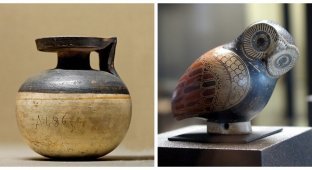Gillette - there is nothing better for a man (9 photos)
Every morning, millions of men start exactly the same: standing in front of the mirror, they soap their cheeks and, taking a razor in their hands, carefully shave off the stubble that has grown over the day. And every second razor has "Gillette" written on it. 
It is believed that moustaches and beards always adorn a real man. The ancient Greeks proudly wore these signs of gender, inherent only to men. But even then, many men shaved off their stubble, and among sculptural portraits and frescoes, we constantly find men's faces with clean-shaven chins.
In Ancient Rome, wearing a beard was already considered a sign of barbarity. Men shaved in the following centuries, Catholic monks shaved not only their cheeks and chins, but even the tops of their heads. At first, men shaved with whatever came to hand: scrapers, fragments of mollusk shells, then razors appeared - stone, obsidian, copper, iron.
The shaving process was long, difficult and, at times, dangerous. The first barbers appeared in Ancient Greece and Ancient Rome, they were very respected people and earned good money. Citizens of all classes used their services, even emperors. This continued until the beginning of the 20th century.
To the delight of the entire male population of the planet, in the USA, in the state of Wisconsin, in the town of Fondulaca (Lake Deep) in 1855, King Camp Gillette was born. His parents, having named him King, were right, their son really did become a "razor king", but it didn't happen right away.
His father, the owner of a hardware store in Chicago, was obsessed with invention. His sons adopted this passion. The family was constantly doing, inventing, and tinkering. After the famous Chicago fire of 1871, which destroyed the store, Gillette Sr. could not bear the blow of fate and began to drink.
The family moved to New York, where 16-year-old King began working as a traveling salesman. Traveling from city to city, he never stopped inventing, dreaming, like Edison, of getting rich on his inventions. Gillette patented all of his inventions, but they did not bring any tangible profit. However, King believed that one day one of his inventions would make him rich. 
In 1891, King got a job as a traveling salesman for the Baltimor Seal Company, whose founder, William Painter, suggested to Gillette the direction of searching for an idea for a new invention. He advised to invent something that would have a one-time use, but would be at the same time widely needed.
William Painter knew what he was talking about; before the era of plastic containers, almost every glass bottle was closed with a crown cork, invented and patented by Painter. 
In 1895, while shaving, Gillette had an epiphany. He decided to separate the dangerous razor into two components: a constantly used handle and a replaceable blade. Instantly, he saw in his head the design of a razor down to the smallest detail: a T-shaped handle with two plates and a thin, sharp strip of steel between them.
As an experienced traveling salesman, he immediately realized that he had found his "gold mine." Every man who shaved would become his client. (It never occurred to him that his invention would be appreciated not only by men, but also by women!) Inspired by the prospects that were opening up, King sent his wife a telegram: "We are rich!"
But he would become rich only in 11 years. 
If Gillette had had even the basics of technical knowledge, he would have abandoned his venture at the very beginning. At that time, making steel that was strong, thin, and cheap enough to be thrown away after a few uses seemed like an impossible task.
Six years passed in fruitless attempts to find a person who was not only capable of solving this problem, but at least willing to take it on. Even at the Massachusetts Institute of Technology, the most authoritative scientific center at that time, they only laughed at his proposal: "It's like trying to sew a dress from one thread."
In 1901, fate brought King together with engineer William Nickerson, who took on the implementation of the crazy idea of the crazy Gillette.
Nickerson was talented. In the same 1901, he received a thin strip of steel of the required strength with a certain sharpening angle. The jubilant partners did not even suspect what ordeals awaited them, that they would have to spend about 250 thousand dollars on laboratory tests alone! 
The partners registered the Gillette Sofety Razor Company and issued shares that were worthless at the time. But there were some simpletons who bought these shares (to the delight of their descendants).
By 1903, by hook or by crook, having collected $5,000, Gillette and Nickerson launched a factory in Boston to produce razors with replaceable blades. At the time of the launch of serial production, the company was $12,000 in debt.
In the first year, the company sold 168 razors and 51 blades. Such results were enough to make one stab oneself with the blade they had invented. 
But King believed in his razor and made heroic efforts to promote his invention. That's when his experience as a traveling salesman came in handy, his ability to convince people to buy something that they absolutely don't need as an absolute necessity.
Gillette sells razors below cost, he gives them away for free, he sells razors bundled with coffee bags, chewing gum, and canned meat.
He sells large quantities of razors to banks, convincing them to give Gillette razors to customers as a bonus when they open an account. Thanks to his efforts, large companies buy the machines and give them to their employees on birthdays and wedding anniversaries.
In the second year, 90,000 machines and 123,000 blades were sold. By 1917, the company was selling 1 million machines and 120 million blades.
In 1917, Gillette obtained an exclusive contract from the US government to supply 3.5 million machines and 36 million blades to soldiers in the active army.
This was his finest hour: soldiers returning from the war no longer wanted to shave with anything other than Gillette machines. King Gillette, as he dreamed, became a millionaire. 
With the end of World War I, King Gillette, who was already in his seventh decade, sold a significant part of his shares, bought an estate in California with orange plantations, and died in 1931 in fame and fortune.
The company he created successfully existed throughout the 20th century and confidently entered the 21st at the zenith of its power.
In 1999, the Gillette company was worth 93 billion dollars, the brand itself was worth 16. From 1975 to 1991, large whales tried to absorb the company three times, but the company survived. In 2005, Gillette Company merged with Procter & Gamble. 
During its existence, the original design of the machine has undergone significant changes. Machines with two, three or more blades, floating blades and floating heads, with a lubricating strip above a row of blades, a vibrator, and other improvements appeared.
But in the main - it is still the same T-shaped handle with a cutting plate fixed to it, invented in 1895 by King Camp Gillette, who earned the immense gratitude of most of the male population of the planet. 


























